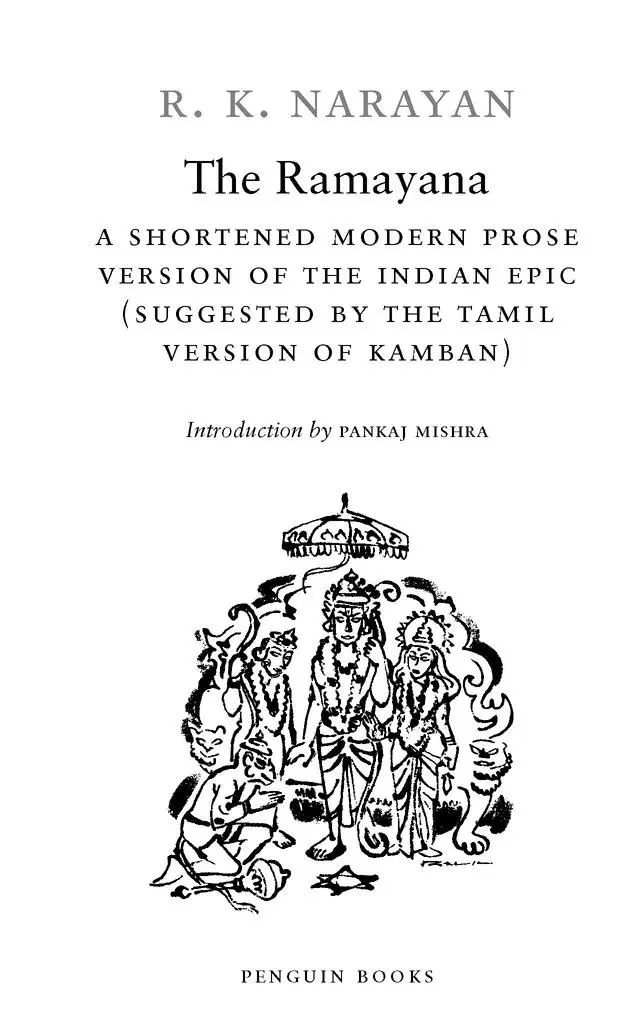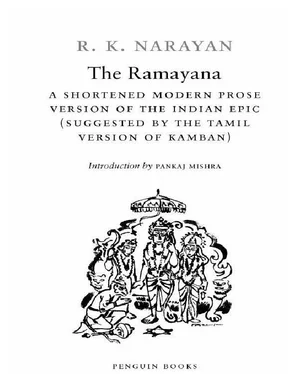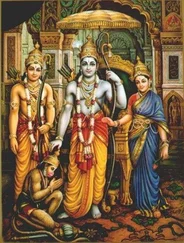Махариши Вальмики - The Ramayana
Здесь есть возможность читать онлайн «Махариши Вальмики - The Ramayana» весь текст электронной книги совершенно бесплатно (целиком полную версию без сокращений). В некоторых случаях можно слушать аудио, скачать через торрент в формате fb2 и присутствует краткое содержание. Жанр: Старинная литература, на английском языке. Описание произведения, (предисловие) а так же отзывы посетителей доступны на портале библиотеки ЛибКат.
- Название:The Ramayana
- Автор:
- Жанр:
- Год:неизвестен
- ISBN:нет данных
- Рейтинг книги:3 / 5. Голосов: 1
-
Избранное:Добавить в избранное
- Отзывы:
-
Ваша оценка:
- 60
- 1
- 2
- 3
- 4
- 5
The Ramayana: краткое содержание, описание и аннотация
Предлагаем к чтению аннотацию, описание, краткое содержание или предисловие (зависит от того, что написал сам автор книги «The Ramayana»). Если вы не нашли необходимую информацию о книге — напишите в комментариях, мы постараемся отыскать её.
The Ramayana — читать онлайн бесплатно полную книгу (весь текст) целиком
Ниже представлен текст книги, разбитый по страницам. Система сохранения места последней прочитанной страницы, позволяет с удобством читать онлайн бесплатно книгу «The Ramayana», без необходимости каждый раз заново искать на чём Вы остановились. Поставьте закладку, и сможете в любой момент перейти на страницу, на которой закончили чтение.
Интервал:
Закладка:
Table of Contents
About the Author
Title Page
Copyright Page
Introduction
Dedication
Chapter 1 - RAMA’S INITIATION
Chapter 2 - THE WEDDING
Chapter 3 - TWO PROMISES REVIVED
Chapter 4 - ENCOUNTERS IN EXILE
Chapter 5 - THE GRAND TORMENTOR
Chapter 6 - VALI
Chapter 7 - WHEN THE RAINS CEASE
Chapter 8 - MEMENTO FROM RAMA
Chapter 9 - RAVANA IN COUNCIL
Chapter 10 - ACROSS THE OCEAN
Chapter 11 - THE SIEGE OF LANKA
Chapter 12 - RAMA AND RAVANA IN BATTLE
Chapter 13 - INTERLUDE
Chapter 14 - THE CORONATION
Epilogue
Glossary

THE RAMAYANA
R. K. NARAYAN was born on October 10, 1906, in Madras, South India, and educated there and at Maharaja’s College in Mysore. His first novel, Swami and Friends (1935), and its successor, The Bachelor of Arts (1937), are both set in the fictional territory of Malgudi, of which John Updike wrote, “Few writers since Dickens can match the effect of colorful teeming that Narayan’s fictional city of Malgudi conveys; its population is as sharply chiseled as a temple frieze, and as endless, with always, one feels, more characters round the corner.” Narayan wrote many more novels set in Malgudi, including The English Teacher (1945), The Financial Expert (1952), and The Guide (1958), which won him the Sahitya Akademi (India’s National Academy of Letters) Award, his country’s highest honor. His collections of short fiction include A Horse and Two Goats , Malgudi Days , and Under the Banyan Tree . Graham Greene, Narayan’s friend and literary champion, said, “He has offered me a second home. Without him I could never have known what it is like to be Indian.” Narayan’s fiction earned him comparisons to the work of writers including Anton Chekhov, William Faulkner, O. Henry, and Flannery O’Connor.
Narayan also published travel books, volumes of essays, the memoir My Days , and the retold legends Gods, Demons, and Others , The Ramayana, and The Mahabharata . In 1980 he was awarded the A. C. Benson Medal by the Royal Society of Literature, and in 1981 he was made an Honorary Member of the American Academy of Arts and Letters. In 1989 he was made a member of the Rajya Sabha, the nonelective House of Parliament in India.
R. K. Narayan died in Madras on May 13, 2001.
PANKAJ MISHRA is the author of The Romantics, winner of the Los Angeles Times ’s Art Seidenbaum Award for First Fiction, An End to Suffering: The Buddha in the World , and Tempations of the West: How to be Modern in India, Pakistan, Tibet, and Beyond . He is a frequent contributor to the New York Times Book Review, the New York Review of Books, and the Guardian .

PENGUIN BOOKS
Published by the Penguin Group
Penguin Group (USA) Inc., 375 Hudson Street, New York, New York 10014, U.S.A.
Penguin Group (Canada), 90 Eglinton Avenue East, Suite 700, Toronto,
Ontario, Canada M4P 2Y3 (a division of Pearson Penguin Canada Inc.)
Penguin Books Ltd, 80 Strand, London WC2R 0RL, England
Penguin Ireland, 25 St Stephen’s Green, Dublin 2, Ireland (a division of Penguin Books Ltd)
Penguin Group (Australia), 250 Camberwell Road, Camberwell,
Victoria 3124, Australia (a division of Pearson Australia Group Pty Ltd)
Penguin Books India Pvt Ltd, 11 Community Centre, Panchsheel Park, New Delhi - 110 017, India
Penguin Group (NZ), cnr Airborne and Rosedale Roads, Albany,
Auckland 1310, New Zealand (a division of Pearson New Zealand Ltd)
Penguin Books (South Africa) (Pty) Ltd, 24 Sturdee Avenue,
Rosebank, Johannesburg 2196, South Africa
Penguin Books Ltd, Registered Offices:
80 Strand, London WC2R 0RL, England
First published in the United States of America by The Viking Press 1972
First published in Great Britain by Chatto & Windus 1973
Published in Penguin Books (U.S.A.) 1977
Published in Penguin Books (U.K) 1977
This edition with an introduction by Pankaj Mishra published in Penguin Books (U.S.A.) 2006
Copyright © R. K. Narayan, 1972
Introduction copyright © Pankaj Mishra, 2006
All rights reserved
The decorations, drawn from Indian temple sculptures, are by R. K. Laxman.
LIBRARY OF CONGRESS CATALOGING IN PUBLICATION DATA
Narayan, R. K., 1906-2001.
The Ramayana : a shortened modern prose version of the Indian epic (suggested by the Tamil version of
Kamban) / R.K. Narayan ; introduction by Pankaj Mishra.
p. cm.—(Penguin classics)
eISBN : 978-0-143-03967-9
1. Rama (Hindu deity)—Fiction. 2. Epic literature, Tamil—Adaptations. I. Kampar, 9th cent.
Ramayanam. II. Title. III. Series.
PR9499.3.N3R36 2006
297.5’922—dc22 2006045201
The scanning, uploading and distribution of this book via the Internet or via any other means
without the permission of the publisher is illegal and punishable by law. Please purchase
only authorized electronic editions, and do not participate in or encourage electronic
piracy of copyrighted materials. Your support of the author’s rights is appreciated.
http://us.penguingroup.com
Introduction
In the summer of 1988 sanitation workers across North India went on strike. Their demand was simple: they wanted the federal government to sponsor more episodes of a television serial based on the Indian epic Ramayana (Romance of Rama). The serial, which had been running on India’s state-owned television channel for more than a year, had proved to be an extraordinarly popular phenomenon, with more than eighty million Indians tuning in to every weekly episode. Streets in all towns and cities emptied on Sunday mornings as the serial went on the air. In villages with no electricity people usually gathered around a rented television set powered by a car battery. Many bathed ritually and garlanded their television sets before settling down to watch Rama, the embodiment of righteousness, triumph over adversity.
When the government, faced with rising garbage mounds and a growing risk of epidemics, finally relented and commissioned more episodes of The Ramayana, not just the sanitation workers but millions of Indians celebrated. More than a decade and many reruns later, the serial continues to inspire reverence among Indians everywhere, and remains for many the primary mode of experiencing India’s most popular epic.
The reasons for this may not be immediately clear to an uninitiated outsider: the serial, cheaply made by a Bollywood filmmaker, abounds in ham acting and tinselly sets, and the long, white beards of its many wise, elderly men look perilously close to dropping off.
But it wasn’t so much its kitschy, Bollywood aspect that endeared the serialization to Indians as its invoking of what is easily the most influential narrative tradition in human history: the story of Rama, the unjustly exiled prince. It may be impossible to prove R. K. Narayan’s claim that every Indian “is aware of the story of The Ramayana in some measure or other.” But it will sound true to most Indians. Indeed, the popular appeal of the story of Rama among ordinary people distinguishes it from much of Indian literary tradition, which, supervised by upper-caste Hindus, has been forbiddingly elitist.
Читать дальшеИнтервал:
Закладка:
Похожие книги на «The Ramayana»
Представляем Вашему вниманию похожие книги на «The Ramayana» списком для выбора. Мы отобрали схожую по названию и смыслу литературу в надежде предоставить читателям больше вариантов отыскать новые, интересные, ещё непрочитанные произведения.
Обсуждение, отзывы о книге «The Ramayana» и просто собственные мнения читателей. Оставьте ваши комментарии, напишите, что Вы думаете о произведении, его смысле или главных героях. Укажите что конкретно понравилось, а что нет, и почему Вы так считаете.












